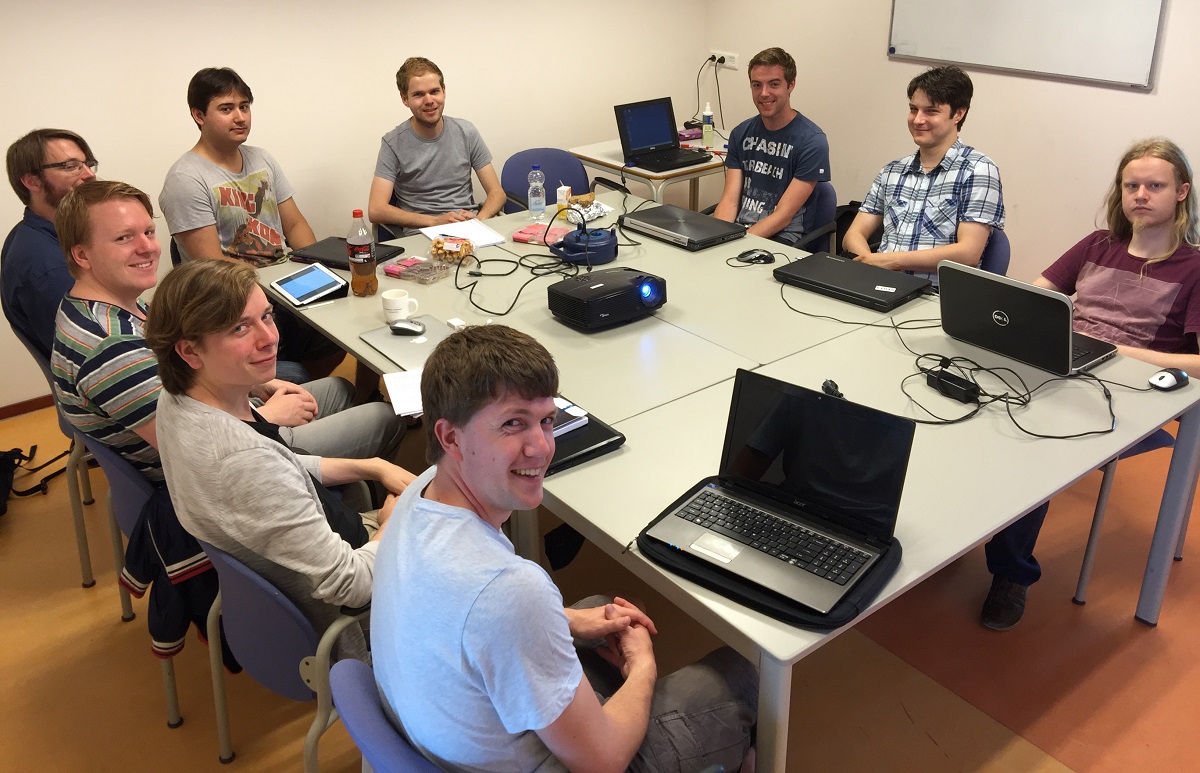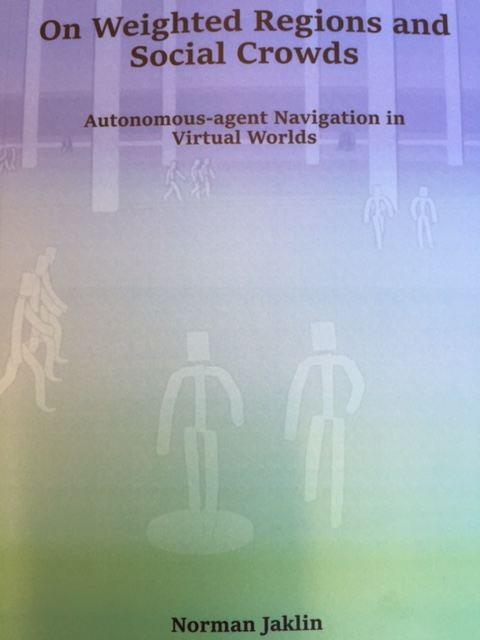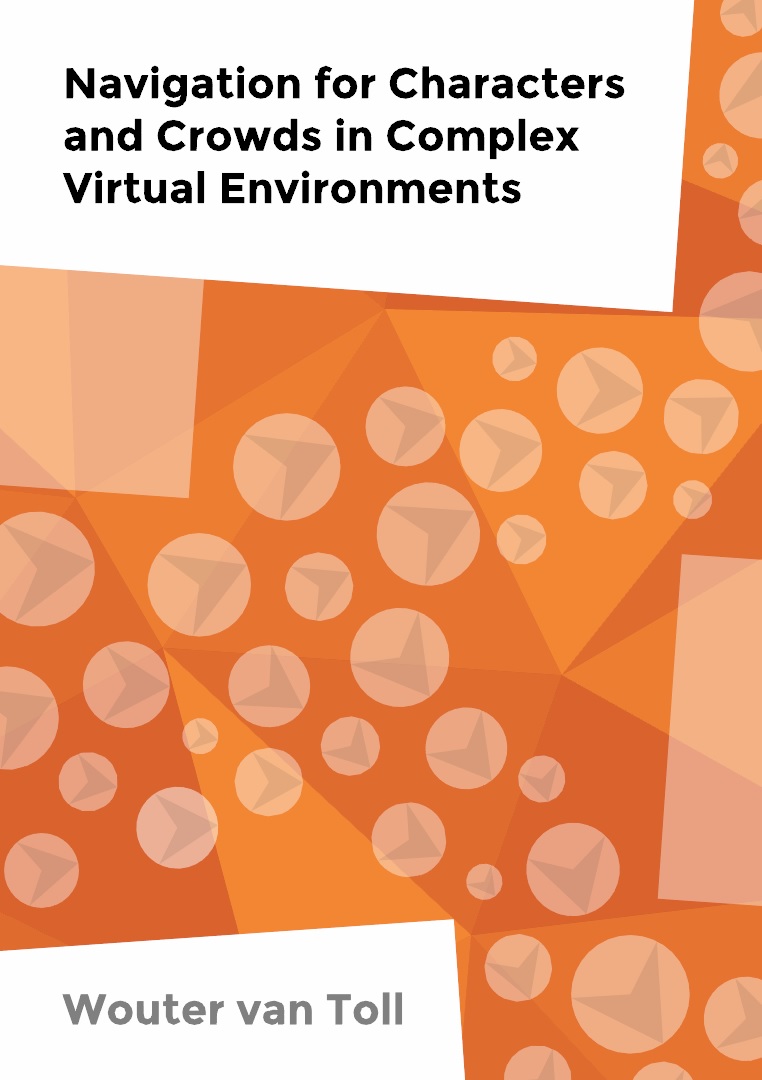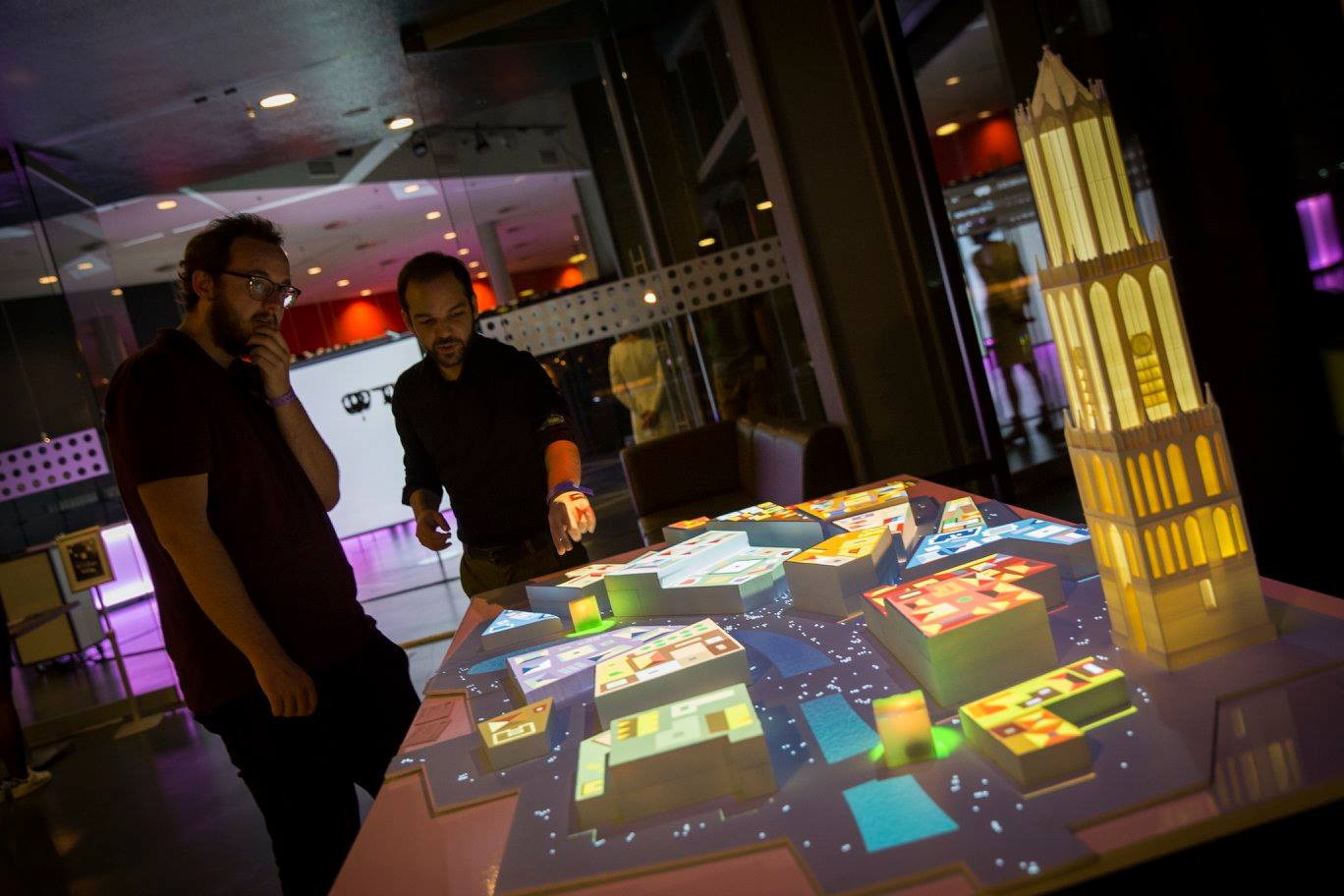We study how we can automatically create a data structure that represents the walkable surfaces in virtual environments, and how it can be updated dynamically and efficiently when it changes. We refer to this structure as a navigation mesh. This mesh enables efficient crowd simulation, which is our next topic of research. We study and develop a crowd simulation framework and its components, which ranges from global (AI) planning to local animation. We create models for realistic crowd behaviors, which includes studying how (groups of) people move and avoid collisions in such environments, based on agent profiles and semantics (such as terrain annotations).

Monthly crowd simulation research meeting
PhD students
I have supervised the following PhD students:

PhD Thesis Norman Jaklin

PhD Thesis Wouter van Toll
I've supervised the following PhD student:
Many pictures and movies on this website are made by them!
Scientific programmers
I have supervised the following scientific programmers:

Presentation of our augmented-reality crowd simulation table at the Betweterfestival in TivoliVredenburg by Angelos Kremyzas. (c) Roswitha de Boer.
List of supervised MSc theses
- K. Haverkort. Integrating real-time crowd simulations in web-based geospatial data platforms. July 2023.
- C. Oliveros. Crowd Simulation in Generated Multi-Layered Environments From Building Information Models. July 2022.
- D. Kalender. Walkable Area Extraction and Crowd Simulation in generated Multi-Layered Environments From Building Information Models. May 2022.
- M. van der Kroon. Using simulations to stimulate higher-order thinking in the solving complex problems. January 2022.
- N. Savenije. Studying the effectiveness and algorithms of digital simulations on an interactive AR crowd simulation table. December 2021.
- Y. Guo Towards. Real-Time and Interactive Crowd Simulations as a Service. October 2021.
- F. Buenen. Towards Real-Time and Interactive Crowd Simulations as a Service. July 2021.
- S. Herfst. Optimizing k-NN Queries for Dense Interactive Real-time Crowd Simulations. January 2021.
- Y. Wegereef. Constructing a Navigaton Mesh by Triangulating the Walkable Area. January 2021.
- M. Noordermeer. Minimizing Memory Costs of Real-Time Interactive Crowd Simulation. December 2020.
- W. van der Waal. High Level Planning in Crowd Simulation. October 2020.
- F. de Vries. Processing of Building Information Models for crowd simulations. October 2020.
- D. Tichelaar. Crowd Simulation Environment Generation From GIS Data. August 2020.
- N. Brouwer. User-centric authoring tool for pedestrian simulation. December 2019.
- R. van den Waardenburg. Parallelization and optimization of the walkable area mesh generating pipeline. March 2019.
- C. Hameleers. Crowd Simulation as a Service: A scalable, real-time architecture. February 2019.
- K. Machlab. Large-scale distributed crowd simulation in real-time. February 2019.
- I. Cirkovic. EvoEnvi: A Collaborative Serious Game Played On An Interactive Table For Teaching Evolution Using Genetic Algorithms. July 2018.
- M. Zwerver. Improved Deadlock Detection and Detours: An extension for MIRAN. September 2018.
- J. Huisen. Scalable Informed Environments using Hierarchical Data Structures and Building Blocks. August 2018.
- Y. Zhao. Verification and validation of the evacuation model. February 2018.
- N. Roumimper. Mesh Navigation Through Jumping. March 2017.
- J. Vermeulen. Bridging gaps in walkable environments. March 2017.
- P. van de Kerkhof. Navigating Jumping Agents Through Virtual Environments. July 2016.
- M. Koenis. Impact of Pedestrians Bringing Along Their Bicycles on Evacuation Times of Subway Stations. June 2016.
- M. Polak. Extracting walkable areas from 3D environments. February 2016.
- M. van der Zwan. The Impact of Density Measurement on the Fundamental Diagram. January 2016.
- T. de Goeij. Background Traffic Agents for Driving Simulators - Simulating Traffic in Multiple Environments. December 2015.
- S. Rosman. Path planning for cyclists - Simulating bicycles in urban environments. August 2015.
- A. Kremyzas. Social Group Behavior and Path Planning. January 2015.
- R. Triesscheijn. A Comparative Study of Navigation Meshes. December 2014.
- M. Bloemheuvel. Creating Dynamic and Density Dependent Indicative Routes for Crowd Simulation. September 2014.
- T. Verbruggen. Maintaining formations in high-density crowds. July 2014.
- M. Tibboel. Creating high quality indicative routes in heterogeneous virtual environments. August 2013.
- R. Bonfiglioli. Computing High Resolution Explicit Corridor Maps using Parallel Technologies. July 2013.
- A. Cibotaru. Alternative algorithms for computing Explicit Corridor Maps using exact and topology-oriented paradigms. May 2013.
- A. Weterings. Path planning for agents with a variable radius and height. May 2013.
- A. Hillebrand. Separating a polygonal environment into a multi-layered environment. November 2012.
- A. van Goethem. A Stream algorithm for crowd simulation to improve crowd coordination at all densities. August 2012.
- W. Saaltink. Partitioning polygonal environments into multi-layered environments. January 2012.
- W. van Toll. A navigation mesh for efficient density-based crowd simulation in multi-layered environments. August 2011.
- C. Prins. Multi-unit pathfinding and column generation. August 2010.
- E. Schager. Stealth-based path planning in virtual environments. August 2009.
- D. Caron. Rhythmic Animations Synthesizing Salsa. August 2009.
- J. Ouwerkerk. Path planning for coherent groups using the Corridor Map Method. October 2008.
- O. Jansen. Path Planning with Scripts. June 2007.




